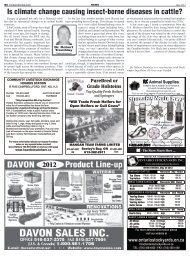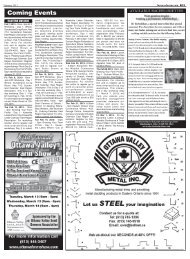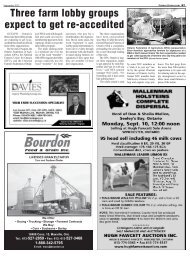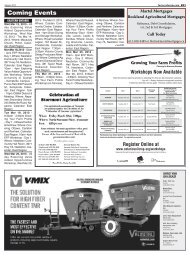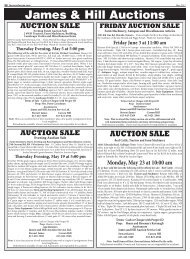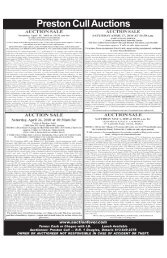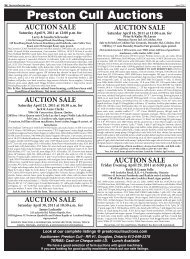Reducing the Risk of Fire on Your Farm - Ontario Ministry of ...
Reducing the Risk of Fire on Your Farm - Ontario Ministry of ...
Reducing the Risk of Fire on Your Farm - Ontario Ministry of ...
- No tags were found...
Create successful ePaper yourself
Turn your PDF publications into a flip-book with our unique Google optimized e-Paper software.
REDUCING THE RISK OF FIRE ON YOUR FARMCeilings – typically ro<str<strong>on</strong>g>of</str<strong>on</strong>g> trusses @ 1,200 mm (48 in.) centres, insulated with fiberglass (or equivalent)insulati<strong>on</strong> materials, and with <str<strong>on</strong>g>the</str<strong>on</strong>g> following materials applied to <str<strong>on</strong>g>the</str<strong>on</strong>g> interior surface:Vinyl Low High Some proprietary products are treatedto reduce <str<strong>on</strong>g>the</str<strong>on</strong>g> FSR and SDC – checkwith manufacturer.Corrugated PVC Low High Some proprietary products are treatedto reduce <str<strong>on</strong>g>the</str<strong>on</strong>g> FSR and SDC – checkwith manufacturer.Corrugated fiberglass Low Low Some proprietary products are treatedto reduce <str<strong>on</strong>g>the</str<strong>on</strong>g> FSR and SDC – checkwith manufacturer.Painted/galvanized metal – – Does not support combusti<strong>on</strong> – seeNOTE belowPainted plywood High High Some proprietary products are treatedto reduce <str<strong>on</strong>g>the</str<strong>on</strong>g> FSR and SDC – checkwith manufacturer.Woven polyethylene High High Some proprietary products are treatedto reduce <str<strong>on</strong>g>the</str<strong>on</strong>g> FSR and SDC – checkwith manufacturer.1FSR values relate to a classificati<strong>on</strong> system for various substrates that indicate how far flames will spread in a given amount <str<strong>on</strong>g>of</str<strong>on</strong>g> time.2SDC values are related to <str<strong>on</strong>g>the</str<strong>on</strong>g> smoke c<strong>on</strong>centrati<strong>on</strong>s given <str<strong>on</strong>g>of</str<strong>on</strong>g>f from burning materials.Note: The NFBCC requires that foamed plastic insulati<strong>on</strong> materials are protected or covered. There must be no foamed plastic exposed to <str<strong>on</strong>g>the</str<strong>on</strong>g> spacesoccupied by people and livestock as many foamed plastic insulati<strong>on</strong>s can be accidentally ignited by sparks and o<str<strong>on</strong>g>the</str<strong>on</strong>g>r igniti<strong>on</strong> sources. Once <str<strong>on</strong>g>the</str<strong>on</strong>g>sefoams are ignited, people and livestock are at risk because <str<strong>on</strong>g>the</str<strong>on</strong>g> foams quickly produce flames and toxic smoke. Two suitable covering materials areexterior-grade plywood and galvanized sheet steel since <str<strong>on</strong>g>the</str<strong>on</strong>g>y have acceptable levels <str<strong>on</strong>g>of</str<strong>on</strong>g> fire protecti<strong>on</strong>, durability and moisture resistance.Plastics create very noxious gases when burned. At very high temperatures, <str<strong>on</strong>g>the</str<strong>on</strong>g> gases that develop may suddenlycause flashover <str<strong>on</strong>g>of</str<strong>on</strong>g> <str<strong>on</strong>g>the</str<strong>on</strong>g> entire room and increase <str<strong>on</strong>g>the</str<strong>on</strong>g> rate <str<strong>on</strong>g>of</str<strong>on</strong>g> fire spread.Installati<strong>on</strong> <str<strong>on</strong>g>of</str<strong>on</strong>g> drywall in a high moisture area, like a livestock barn, is not recommended due to <str<strong>on</strong>g>the</str<strong>on</strong>g> highhumidity levels in <str<strong>on</strong>g>the</str<strong>on</strong>g> housing area. Where drywall is used, provide a vapour barrier in an appropriate locati<strong>on</strong>that protects <str<strong>on</strong>g>the</str<strong>on</strong>g> drywall from <str<strong>on</strong>g>the</str<strong>on</strong>g> high moisture envir<strong>on</strong>ment.Drywall can be used in dry envir<strong>on</strong>ment areas <str<strong>on</strong>g>of</str<strong>on</strong>g> <str<strong>on</strong>g>the</str<strong>on</strong>g> barn that do not house livestock. For example, use twolayers <str<strong>on</strong>g>of</str<strong>on</strong>g> fire-rated drywall to line <str<strong>on</strong>g>the</str<strong>on</strong>g> interior <str<strong>on</strong>g>of</str<strong>on</strong>g> <str<strong>on</strong>g>the</str<strong>on</strong>g> mechanical electrical room to provide a fire separati<strong>on</strong>.A fire that starts in this area will take l<strong>on</strong>ger to spread to <str<strong>on</strong>g>the</str<strong>on</strong>g> rest <str<strong>on</strong>g>of</str<strong>on</strong>g> <str<strong>on</strong>g>the</str<strong>on</strong>g> building, providing more time forevacuati<strong>on</strong> and extinguishing.For harsh envir<strong>on</strong>ments (humid and corrosive), choose durable sheathing materials that <str<strong>on</strong>g>of</str<strong>on</strong>g>ten have a higherfire‐resistance rating (i.e. c<strong>on</strong>crete board, sandwich wall c<strong>on</strong>structi<strong>on</strong>, fiberglass-coated plywood).26



